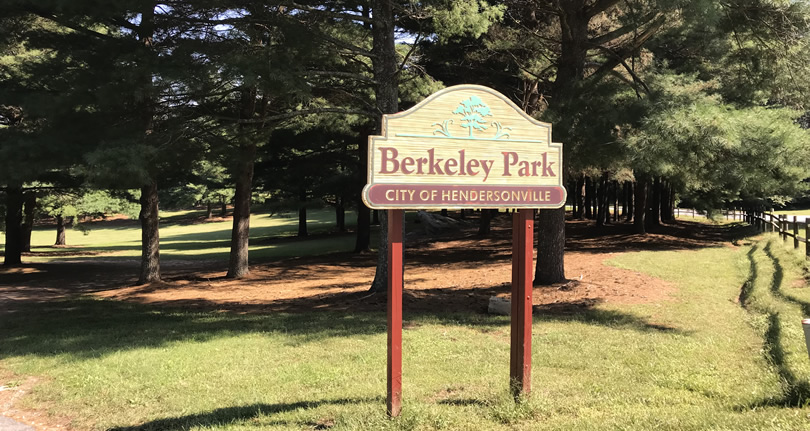Berkley Mills Park has nature trails and a picnic area. It is this end of the Oklawaha Greenway Trail.
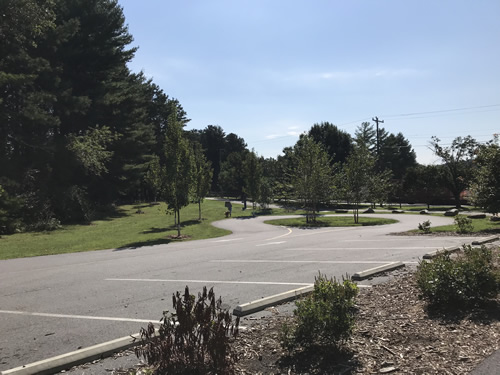
The parking for this end of the Oklawaha Greenway is at Berkley Mills Park. Actually, it is across the road from Berkley Mills Park.
Drive past the entrance to the park on the left to the parking area on the right.
The Oklawaha Greenway leaves from Berkley Mills Park, and then goes south. It follows Mud Creek and goes through different scenery, from back yards to wetland and forest.
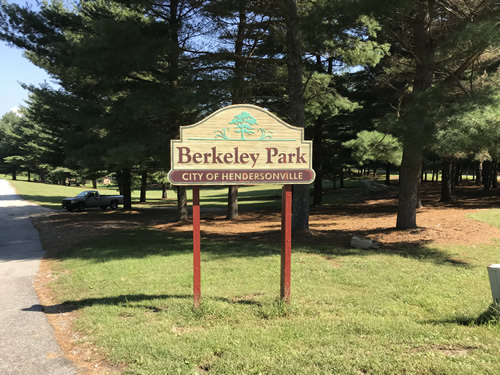
City of Hendersonville
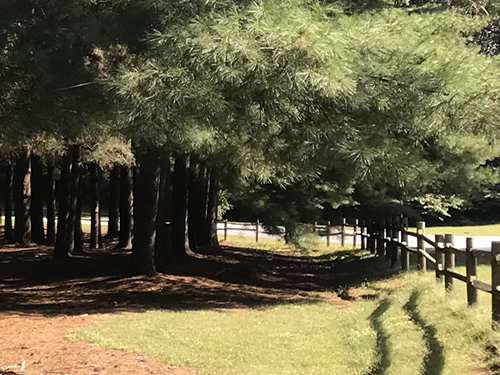
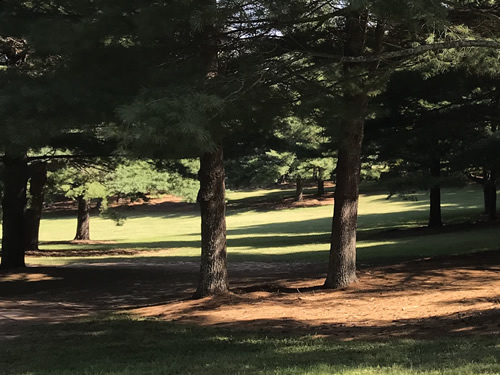
Berkley Mills Park contains the historic Berkeley Park stadium.
Directions to Berkley Mills Park from Meadowbrook Log Cabin
Berkley Mills Park
69 Balfour Road
Berkley Mills Park is very close to Meadowbrook Log Cabin..
- From the cabin, turn left on US-25.
- At the second light, turn right onto Berkely Road.
- At the bottom of the hill, turn left.
- Berkley Mills Park is on the left.
- Parking for the Oklawaha Greenway is on the right.
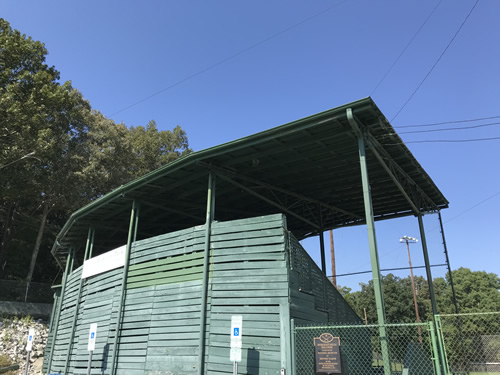
Berkeley Mills Ballpark
Berkeley Ball Park was listed by the National Register of Historic Places Program in 2016 as “Property associated with events that have made a significant contribution to the broad patterns of our history”.
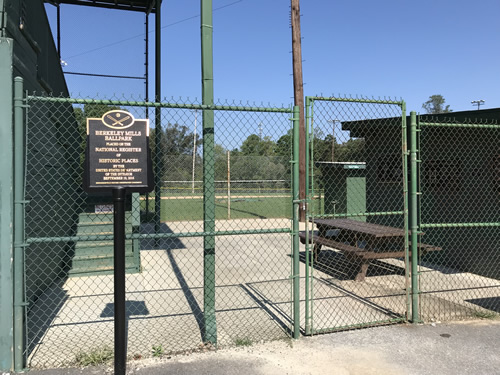
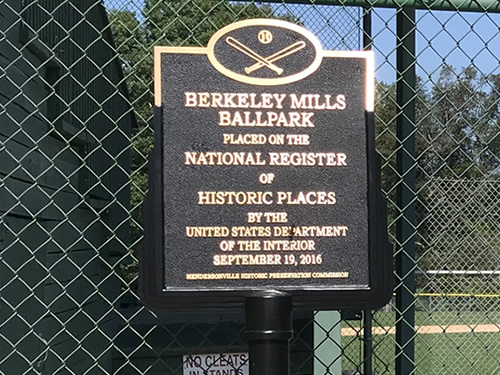
The park was considered worthy of preservation as one of the Nation’s historic places through the National Register of Historic Places Program.
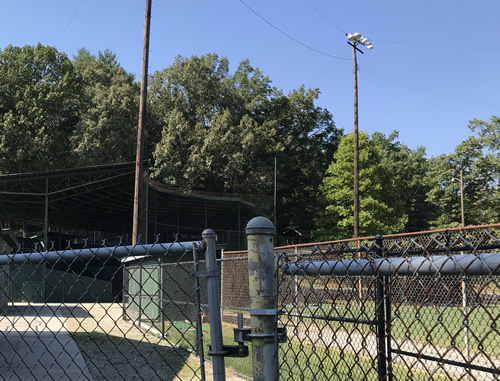
The field dates to 1949 and the grandstand was built at the same time. The grandstand was roofed and the field had electric lighting by early the next year, 1950. The sign says 1946, but the National Register of Historic Places document says “the date is wrong”.
Baseball has been popular in Hendersonville since the end of the Civil War. Hendersonville had an organized team, the Hendersonville Planets, all the way back to 1909. They were in the Western North Carolina League.
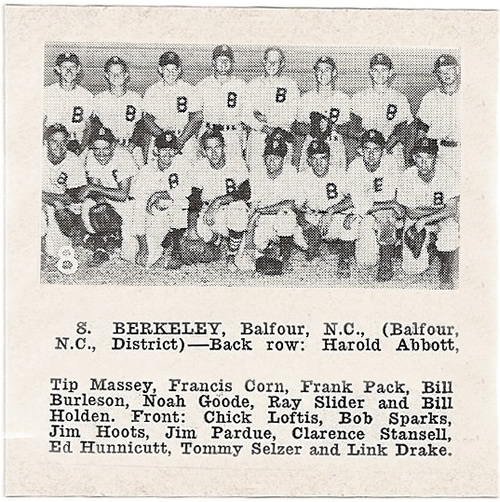
Berkeley Mills sponsored a team in 1948. IT was named the Berkeley Spinners. At this time Berkeley Mills made cotton gauze. A spinner is the machinery used in the mill.
They played against teams like the Ecusta Papermakers. At first they shared a field with the Hendersonville High School team and the Hendersonville Skylarks, owned by Hendersonville automobile dealer T. Lee Osborne.
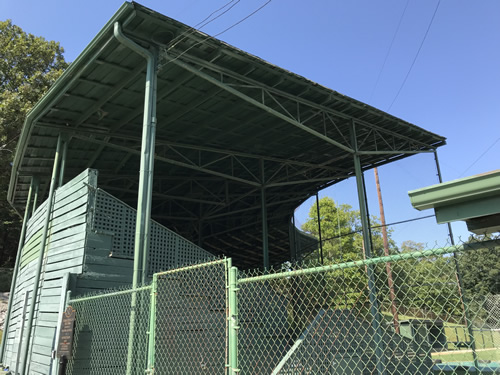
In 1949, Berkeley Mills management built Berkeley Mills Ballpark just north of the mill and the mill village. The area was cleared and bulldozed to level the area.
The Spinners dominated the WNCIL from 1949 through 1953, winning four of five regular season titles during the period. After the 1953 season management searched for a more competitive league and found it in the Spartanburg, South Carolina-based Eastern Carolina League which the Spinners nevertheless swept in 1954.
National Register of Historic Places
But, in 1962, the league was suspended and the Spinners decided not to keep playing. There were fewer workers in the mill, so it was hard to get players and there were fewer spectators.
Other teams used the park, and the picnic grounds and shelters were used by people who worked for the mill for barbecues and picnics. The mill organized employee picnics here. In 2009 Kimberly Clark, who owns the factory now, donated the park with 60 acres to the city of Hendersonville.
The Hendersonville City Council has talked about adding a soccer complex with restrooms, more parking spaces, a playground and picnic area, an amphitheater with a covered stage, trails, a dog park, a youth mountain bike trail and mountain bike skills park and a nine-basket disc golf course.
National Historic Preservation Act
The National Historic Preservation Act of 1966 coordinates and supports public and private efforts to identify, evaluate, and protect America’s historic and archeological resources.
The resource is a baseball sports complex consisting of a 1949 baseball field, 1949-50 grandstand, and other resources dating from the late twentieth century (some or all from the late 1970s) and early twenty-first century. The ballpark lies to the north of Berkeley Mills (now Kimberly Clark), the historic textile mill which had the ballpark constructed and which sponsored its home team, the Berkeley Spinners. The ballpark exists in a park-like setting, tucked against a wooded hill to the southwest scattered with picnic shelters and other amenities, and reached by a gravel road which passes through rolling lawn areas to connect to Balfour Road. A modem sign and wooden split rail fence is at the entrance to the property. The ball field’s level topography is the result of cut and fill that took earth from the grandstand area to create a level raised outfield. The area to the northwest and northeast of the ball field is wooded. A narrow dirt drive encircles the ball field.
National Register of Historic Places
Statement of Significance
Berkeley Mills Ballpark, located in Hendersonville, North Carolina, was established in 1949 as the home field of the Berkeley Spinners, the baseball team of the Berkeley Mills textile plant. Organized in 1948 at the height of baseball’s post-war popularity, the Spinners played as part of the Western North Carolina Industrial League composed of teams drawn from the workforces of various regional industrial plants. The following year Berkeley Mills contracted with Dan Waddell and Company, a Hendersonville grading company, to construct a ball field in a park- like setting to the north of the mills’ factory and mill village. Mill employees assisted with the construction of stands and associated structures. The wood and steel grandstand, built in 1949 and roofed in 1950, is accompanied by an intact ballfield. In 2008, the Kimberly Clark Corporation, successor to Berkeley Mills, donated the ballpark and surrounding park area to the City of Hendersonville. Berkeley Mills Ballpark meets National Register Criterion A in the Entertainment/Recreation area of significance at the local level of significance for its association with industrial league and community baseball in Hendersonville during the historic period. The period of significance extends from initial construction in 1949 through 1966 embracing the years the park served as the home field of the mill-supported Berkeley Spinners baseball team (1949-1961) and the early years ofthe post-Spinners period (1962-1966) when it was used exclusively for non-industrial league ball by a number of teams. Although local teams continued to play at the facility after 1966, this later period is not of exceptional significance.
National Register of Historic Places

